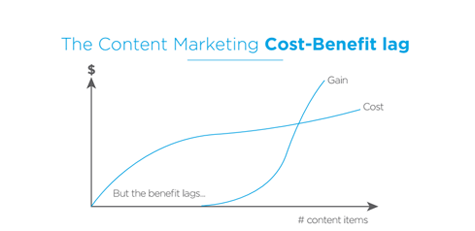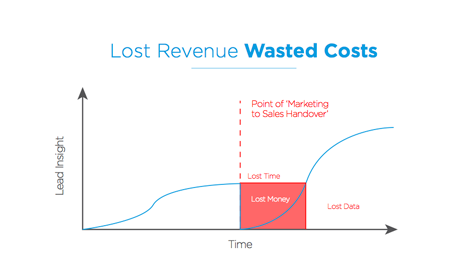Content Marketing - Cost Center or Revenue Driver?

What's the number one question that all revenue-focused marketers should be asking: Is content marketing worth it?
Although content marketing has grown to a $44 billion industry (according to Custom Content Council), for some marketers content marketing is turning into a costly pursuit. A costly pursuit that is looking less and less attractive as the reality of what it takes to create, manage and distribute enough material to feed the content marketing beast hits home.
Forty-two percent of B2B marketers say their content marketing efforts are not effective (source: CMI B2B Content Marketing study) although one should not throw the tactic quite yet: an 'inconvenient truth' about content marketing is that the gains lag behind the upfront costs of producing that content. Many of these B2B marketers are experiencing the natural time-lag between cost and gain.

However, this isn't an exhortation to 'wait it out' until the commercial benefits of content marketing make themselves apparent. On the contrary, if marketing execs started on the road to content marketing, now is the time to make the necessary modifications to their strategy.
So, what can be done to make sure that content doesn't cost organizations big time?
1. Measure the right metrics
While content marketing is a wonderful way to enhance a brand's relationship with customers and prospects, a brand cannot stay in business through measuring engagement alone. For those operating in a purely content marketing function it is very easy to fall back on using engagement metrics (social shares, linkbacks, etc.) instead of moving to business metrics such as number of direct responses (sign-ups, requests for demo/trial), purchases, lead generation, average order of deal size, sales velocity and so forth.
Only 21 percent of content marketers say they are successful at measuring the effectiveness of their content marketing efforts (CMI 2015 Content Marketing Benchmark Study). Marketers can't drive revenue if they're not measuring for it.
2) Review the lead handover process
The lion's share of lost revenue occurs at the handover of a content marketing generated lead to a sales team. It is at handover point that leads either go cold, are rejected or simply forgotten. The reasons for this are manifold but it usually boils down to the prohibitive time that it takes for sales reps to garner enough information about each lead to proceed with a successful sales conversation.

Fixing the lead handover process will look different in every organization but ultimately it relies upon a solid lead management process that is well-defined (including, agreed sales stages and the criteria for a qualified lead at each stage), supported by the right technology and adhered to by personnel in both sales and marketing. Once this process is defined, double-down on making sure that sales reps have all the lead context necessary to make a successful call.
3) Track content consumption to provide lead context to the Sales team
Laura Ramos of Forrester recently on a webinar to discuss the importance of marketers providing Sales support by "moving from nurturing leads to creating a shared customer context." But how can they do that?
The great truth that seems to have eluded content marketers is that content is not just useful for engagement and conversions, but content is integral for better prospect and customer insight. Content consumption reveals who people are, what they are interested in and what pain-point they have. Harnessing this is of huge value for sales reps that need to work off of the best and most insightful lead data to get inside of their prospect's mind and understand what is motivating and driving them; knowing their marketing automation lead score or job title alone will not do this.
4) Use data to understand evolving customer pain-points
Resist the temptation to treat content marketing as merely an art. There's "science" involved, too. Data should play a crucial part in informing ongoing content strategy. Fortunately, there's all sorts of data content marketers can consult to make their content more relevant to their target audience. These include demographic data (who they are), firmographic data (the profile of their company), social data (what they're saying) and in B2B environments, a lead score showing how much and where they've interacted with vendor content. Consider also using "interest data" generated by their content consumption; linking this insight to a CRM program will pay dividends as it identifies the content topics that are most interesting to prospects and which topics in particular are moving them through the sales funnel.
5) Connect the sales team to Marketing's content
Something like "60 percent to 70 percent of content created by B2B companies is never used," according to Tony Jaros, SVP of Research, at Sirius Decisions. With stats like that it's no wonder that content marketing is viewed as a cost center and not a revenue driver!
Salespeople are time poor - they don't have time to fumble around across a litany of marketing folders to find a relevant piece of content to a prospect. Kapost found that 65 percent of sales reps say they can't find content to send to prospects; this represented the most common complaint cited by sales teams in the study. Other reasons included, content being outdated and customers not finding it relevant. Content marketers can fix this by making sure content is well categorized, optimized for relevance, and visible at all times.
The Data Divide
Far from being a prohibitive business cost, content marketing that is data-driven, provides lead insight to sales teams and is measured correctly will deliver positive returns. Not only will companies doing this get a grip on ROI, but they will also reduce the natural time-lag between upfront content marketing costs and the subsequent gains. Only then can content marketing truly be a revenue driver.
Andrew Davies is the CMO and Co-Founder of idio, and helps leading content marketers maximise the value of their content marketing. idio's Content Intelligence platform analyzes your content automatically, understands your customers via the content they consume, and recommends the right content to the right person in real-time, on any channel. To find out more, please visit idioplatform.com and follow Andrew on Twitter @andjdavies.
Subscribe to Our Newsletter!
Latest in Social Media










